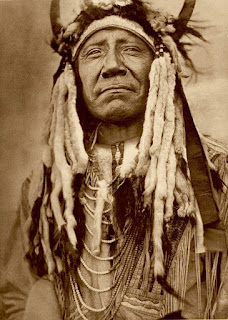Great Leader: Two Moons of the Northern Cheyenne, 1847-1917
The Native victory at Little Bighorn/Greasy Grass on June 26, 1876 was a collaborative effort of several Sioux, Cheyenne and Arapahoe leaders. Two Moons, 1847-1917 was one of those leaders.
 Two Moons was born c 1847 in what is now Montana. His father, Carries the Otter was an Arikara captive who married into the Cheyenne tribe. Little is known of Two Moons' early life, or how he rose to prominence in his society. However, he would lead Cheyenne war partiers in several key battles of the American west. The first was the Battle of the Rosebud on June 17, 1876 against General George Crook, in the windup to the Little Bighorn. Then, Little Bighorn/Greasy Grass on June 26, 1876. Finally, less than a year later, Two Moons would lead his final war party at the Battle of Wolf Mountain on January 8, 1877. There, he was defeated by General Nelson A. Miles and surrendered his band of Cheyenne at Fort Keogh in April, 1877.
Two Moons was born c 1847 in what is now Montana. His father, Carries the Otter was an Arikara captive who married into the Cheyenne tribe. Little is known of Two Moons' early life, or how he rose to prominence in his society. However, he would lead Cheyenne war partiers in several key battles of the American west. The first was the Battle of the Rosebud on June 17, 1876 against General George Crook, in the windup to the Little Bighorn. Then, Little Bighorn/Greasy Grass on June 26, 1876. Finally, less than a year later, Two Moons would lead his final war party at the Battle of Wolf Mountain on January 8, 1877. There, he was defeated by General Nelson A. Miles and surrendered his band of Cheyenne at Fort Keogh in April, 1877.
A new chapter than began for Two Moons. Deciding to make the best of a bad situation, he signed on to become a scout for General Miles. Two Moons was known for a pleasant, outgoing personality and the two men became friends. This was no mean feat, as Miles wasn't really known for his respect for Natives. Miles' sponsorship stood Two Moons in good stead when the government decided to involve itself in Cheyenne affairs and appoint a chief over the Northern Cheyenne Reservation. Two Moons was chosen. There, he would facilitate the surrender of a Cheyenne band under Little Crow. As chief, Two Moons traveled to Washington frequently to advocate on behal of his people. Years later, Two Moons met and spoke with photographer and journalist Edward S. Curtis, who interviewed several survivors of Little Bighorn. Two Moons was one of the models for the buffalo nickel. He died in 1917 and is buried near U.S. Route 212 west of Busby Montana.
 Two Moons was born c 1847 in what is now Montana. His father, Carries the Otter was an Arikara captive who married into the Cheyenne tribe. Little is known of Two Moons' early life, or how he rose to prominence in his society. However, he would lead Cheyenne war partiers in several key battles of the American west. The first was the Battle of the Rosebud on June 17, 1876 against General George Crook, in the windup to the Little Bighorn. Then, Little Bighorn/Greasy Grass on June 26, 1876. Finally, less than a year later, Two Moons would lead his final war party at the Battle of Wolf Mountain on January 8, 1877. There, he was defeated by General Nelson A. Miles and surrendered his band of Cheyenne at Fort Keogh in April, 1877.
Two Moons was born c 1847 in what is now Montana. His father, Carries the Otter was an Arikara captive who married into the Cheyenne tribe. Little is known of Two Moons' early life, or how he rose to prominence in his society. However, he would lead Cheyenne war partiers in several key battles of the American west. The first was the Battle of the Rosebud on June 17, 1876 against General George Crook, in the windup to the Little Bighorn. Then, Little Bighorn/Greasy Grass on June 26, 1876. Finally, less than a year later, Two Moons would lead his final war party at the Battle of Wolf Mountain on January 8, 1877. There, he was defeated by General Nelson A. Miles and surrendered his band of Cheyenne at Fort Keogh in April, 1877. A new chapter than began for Two Moons. Deciding to make the best of a bad situation, he signed on to become a scout for General Miles. Two Moons was known for a pleasant, outgoing personality and the two men became friends. This was no mean feat, as Miles wasn't really known for his respect for Natives. Miles' sponsorship stood Two Moons in good stead when the government decided to involve itself in Cheyenne affairs and appoint a chief over the Northern Cheyenne Reservation. Two Moons was chosen. There, he would facilitate the surrender of a Cheyenne band under Little Crow. As chief, Two Moons traveled to Washington frequently to advocate on behal of his people. Years later, Two Moons met and spoke with photographer and journalist Edward S. Curtis, who interviewed several survivors of Little Bighorn. Two Moons was one of the models for the buffalo nickel. He died in 1917 and is buried near U.S. Route 212 west of Busby Montana.



Comments
Post a Comment